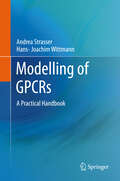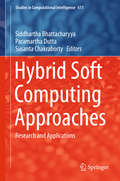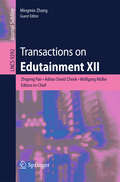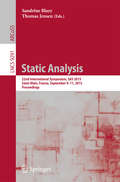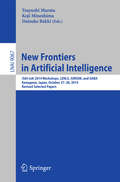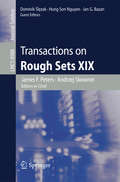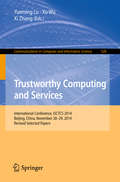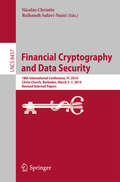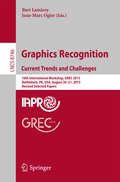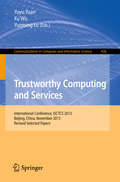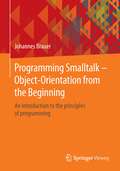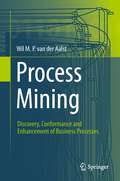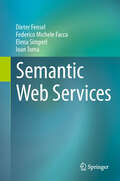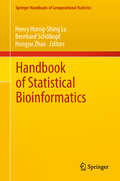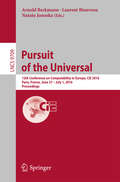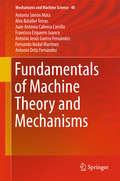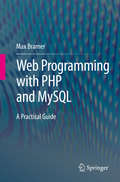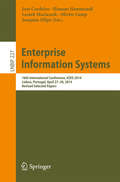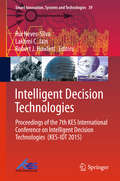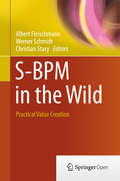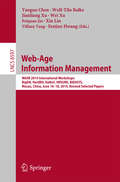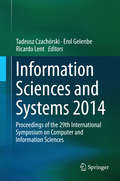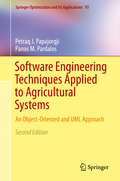- Table View
- List View
Modelling of GPCRs
by Andrea Strasser Hans-Joachim WittmannG protein coupled receptors (GPCRs) comprise an important protein family, which is involved in signal transduction in the cell. Besides that a large number of drugs, available on market, address GPCRs. For an efficient and improved development of appropriate drugs, molecular modelling of GPCRs is - in order to understand the ligand-receptor interactions and functionality of GPCRs on molecular level - an important tool. The book "Modelling of GPCRs - a practical handbook" is focussed onto a practical introduction into molecular modelling of GPCRs. This book is very useful for beginners in GPCR modelling, but also addresses the advanced GPCR modeller: On the one hand, the book introduces principles of GPCR modelling, including extensive examples. On the other hand, detailed outlooks onto advanced GPCR modelling techniques are presented. Furthermore, the book includes important data, like information about crystal structures in a summarized manner or amino acid sequences, which are essential for GPCR modelling in general. Due to an increase in efficacy and data handling most modellers use LINUX as operating system. To address this, a summary of most important LINUX commands with examples is presented within the book.
Hybrid Soft Computing Approaches
by Siddhartha Bhattacharyya Paramartha Dutta Susanta ChakrabortyThe book provides a platform for dealing with the flaws and failings of the soft computing paradigm through different manifestations. The different chapters highlight the necessity of the hybrid soft computing methodology in general with emphasis on several application perspectives in particular. Typical examples include (a) Study of Economic Load Dispatch by Various Hybrid Optimization Techniques, (b) An Application of Color Magnetic Resonance Brain Image Segmentation by Para Optimus LG Activation Function, (c) Hybrid Rough-PSO Approach in Remote Sensing Imagery Analysis, (d) A Study and Analysis of Hybrid Intelligent Techniques for Breast Cancer Detection using Breast Thermograms, and (e) Hybridization of 2D-3D Images for Human Face Recognition. The elaborate findings of the chapters enhance the exhibition of the hybrid soft computing paradigm in the field of intelligent computing.
Transactions on Edutainment XI
by Zhigeng Pan Adrian David Cheok Wolfgang Mueller Mingmin ZhangThis journal subline serves as a forum for stimulating and disseminating innovative research ideas, theories, emerging technologies, empirical investigations, state-of-the-art methods, and tools in all different genres of edutainment, such as game-based learning and serious games, interactive storytelling, virtual learning environments, VR-based education, and related fields. It covers aspects from educational and game theories, human-computer interaction, computer graphics, artificial intelligence, and systems design. The 24 papers presented in this 11th issue were organized in four parts dealing with: object reconstruction and management; graphics; VR/AR; and applications.
Static Analysis
by Sandrine Blazy Thomas JensenThis book constitutes the refereed proceedings of the 22nd International Static Analysis Symposium, SAS 2015, held in Saint-Malo, France, in September 2015. The 18 papers presented in this volume were carefully reviewed and selected from 44 submissions. All fields of static analysis as a fundamental tool for program verification, bug detection, compiler optimization, program understanding, and software maintenance are addressed, featuring theoretical, practical, and application advances in the area
New Frontiers in Artificial Intelligence
by Daisuke Bekki Tsuyoshi Murata Koji MineshimaThis book constitutes the thoroughly refereed post-conference proceedings of the JSAI-isAI 2014 Workshops LENLS, JURISIN, and GABA which tool place on November 2014, in Japan. The 26 contributions in this volume were carefully reviewed and selected from 57 submissions. From the 3 workshops (LENLS11, JURISIN2014, and GABA2014), 23 papers were carefully selected and revised according to the comments of the workshop program committee. LENLS (Logic and Engineering of Natural Language Semantics) is an annual international workshop on formal semantics and pragmatics and it focused on the formal and theoretical aspects of natural language. JURISIN (Juris-informatics) 2014 was the 8th event in the series, the purpose of this workshop was to discuss fundamental and practical issues for juris-informatics, bringing together experts from a variety of relevant backgrounds, including law, social science, information and intelligent technology, logic and philosophy (including the area of AI and law). GABA (Graph-based Algorithms for Big Data and its Applications) 2014 was the first workshop on graph structures including string, tree, bipartite- and di-graph for knowledge discovery in big data. The purpose of this workshop was to discuss ideas for realizing big data integration, including algorithms with theoretical / experimental results.
Transactions on Rough Sets XIX
by James F. Peters Andrzej Skowron Hung Son Nguyen Dominik Ślȩzak Jan G. BazanThe LNCS journal Transactions on Rough Sets is devoted to the entire spectrum of rough sets related issues, from logical and mathematical foundations, through all aspects of rough set theory and its applications, such as data mining, knowledge discovery, and intelligent information processing, to relations between rough sets and other approaches to uncertainty, vagueness, and incompleteness, such as fuzzy sets and theory of evidence. Volume XIX in the series focuses on the current trends and advances in both the foundations and practical applications of rough sets. It contains 7 extended and revised papers originally presented at the Workshop on Rough Set Applications, RSA 2012, held in Wroclaw, Poland, in September 2012. In addition, the book features 3 contributions in the category of short surveys and monographs on the topic.
Trustworthy Computing and Services
by Xi Zhang Xu Wu Yueming LuThis book constitutes the refereed proceedings of the International Standard Conference on Trustworthy Computing and Services, ISCTCS 2014, held in Beijing, China, in November 2014. The 51 revised full papers presented were carefully reviewed and selected from 279 submissions. The topics covered are architecture for trusted computing systems; trusted computing platform; trusted system building; network and protocol security; mobile network security; network survivability, other critical theories and standard systems; credible assessment; credible measurement and metrics; trusted systems; trusted networks; trusted mobile networks; trusted routing; trusted software; trusted operating systems; trusted storage; fault-tolerant computing and other key technologies; trusted e-commerce and e-government; trusted logistics; trusted internet of things; trusted cloud and other trusted services and applications.
Financial Cryptography and Data Security
by Nicolas Christin Reihaneh Safavi-NainiThis book constitutes the thoroughly refereed post-conference proceedings of the 18th International Conference on Financial Cryptography and Data Security (FC 2014), held in Christ Church, Barbados, in March 2014. The 19 revised full papers and 12 short papers were carefully selected and reviewed from 165 abstract registrations and 138 full papers submissions. The papers are grouped in the following topical sections: payment systems, case studies, cloud and virtualization, elliptic curve cryptography, privacy-preserving systems, authentication and visual encryption, network security, mobile system security, incentives, game theory and risk, and bitcoin anonymity.
Graphics Recognition. Current Trends and Challenges
by Bart Lamiroy Jean-Marc OgierThis book constitutes the thoroughly refereed post-conference proceedings of the 10th International Workshop on Graphics Recognition, GREC 2013, held in Bethlehem, PA, USA, in August 2013. The 20 revised full papers presented were carefully reviewed and selected from 32 initial submissions. Graphics recognition is a subfield of document image analysis that deals with graphical entities in engineering drawings, sketches, maps, architectural plans, musical scores, mathematical notation, tables, and diagrams. Accordingly the conference papers are organized in 5 topical sessions on symbol spotting and retrieval, graphics recognition in context, structural and perceptual based approaches, low level processing, and performance evaluation and ground truthing.
Trustworthy Computing and Services
by Yuyu Yuan Xu Wu Yueming LuThis book constitutes the refereed proceedings of the International Standard Conference on Trustworthy Distributed Computing and Services, ISCTCS 2013, held in Beijing, China, in November 2013. The 49 revised full papers presented were carefully reviewed and selected from 267 papers. The topics covered are trustworthy infrastructure; security, survivability and fault tolerance; standards, evaluation and certification; trustworthiness of services.
Programming Smalltalk - Object-Orientation from the Beginning
by Johannes BrauerA straightforward, step-by-step introduction to clear and elegant object-oriented programming. Using a language that's perfect for this kind of programming, the book has been tested in numerous courses and workshops over ten years. Programming Smalltalk is particularly suited for readers with no prior programming knowledge. Starting from the first principles of programming, it teaches you how to use and create algorithms (reusable rules for problem-solving) and the basic building blocks of software. It goes on to explain how to develop complete applications and has a whole chapter on web applications as well as case studies. Now translated into English, this edition was completely revised to be consistent with the latest version of Cincom® VisualWorks®, a professional Smalltalk environment. All examples were created using VisualWorks, which is available without cost for educational purposes, and can be downloaded and installed on any up-to-date computer.
Process Mining
by Wil M. van der AalstThe first to cover this missing link between data mining and process modeling, this book provides real-world techniques for monitoring and analyzing processes in real time. It is a powerful new tool destined to play a key role in business process management.
Semantic Web Services
by Dieter Fensel Elena Simperl Federico Michele Facca Ioan TomaA paradigm shift is taking place in computer science: one generation ago, we learned to abstract from hardware to software, now we are abstracting from software to serviceware implemented through service-oriented computing. Yet ensuring interoperability in open, heterogeneous, and dynamically changing environments, such as the Internet, remains a major challenge for actual machine-to-machine integration. Usually significant problems in aligning data, processes, and protocols appear as soon as a specific piece of functionality is used within a different application context. The Semantic Web Services (SWS) approach is about describing services with metadata on the basis of domain ontologies as a means to enable their automatic location, execution, combination, and use. Fensel and his coauthors provide a comprehensive overview of SWS in line with actual industrial practice. They introduce the main sociotechnological components that ground the SWS vision (like Web Science, Service Science, and service-oriented architectures) and several approaches that realize it, e.g. the Web Service Modeling Framework, OWL-S, and RESTful services. The real-world relevance is emphasized through a series of case studies from large-scale R&D projects and a business-oriented proposition from the SWS technology provider Seekda. Each chapter of the book is structured according to a predefined template, covering both theoretical and practical aspects, and including walk-through examples and hands-on exercises. Additional learning material is available on the book website www.swsbook.org. With its additional features, the book is ideally suited as the basis for courses or self-study in this field, and it may also serve as a reference for researchers looking for a state-of-the-art overview of formalisms, methods, tools, and applications related to SWS.
Handbook of Statistical Bioinformatics
by Bernhard Schölkopf Henry Horng-Shing Lu Hongyu ZhaoNumerous fascinating breakthroughs in biotechnology have generated large volumes and diverse types of high throughput data that demand the development of efficient and appropriate tools in computational statistics integrated with biological knowledge and computational algorithms. This volume collects contributed chapters from leading researchers to survey the many active research topics and promote the visibility of this research area. This volume is intended to provide an introductory and reference book for students and researchers who are interested in the recent developments of computational statistics in computational biology.
Pursuit of the Universal
by Arnold Beckmann Laurent Bienvenu Nataša JonoskaThis book constitutes the refereed proceedings of the 12th Conference on Computability in Europe, CiE 2016, held in Paris, France, in June/July 2016. The 18 revised full papers and 19 invited papers and invited extended abstracts were carefully reviewed and selected from 40 submissions. The conference CiE 2016 has six special sessions - two sessions, cryptography and information theory and symbolic dynamics, are organized for the first time in the conference series. In addition to this new developments in areas frequently covered in the CiE conference series were addressed in the following sessions: computable and constructive analysis; computation in biological systems; history and philosophy of computing; weak arithmetic.
Innovative Approaches and Solutions in Advanced Intelligent Systems
by Gennady Agre Svetozar Margenov Galia AngelovaThis volume is a selected collection of papers presented and discussedat the International Conference "Advanced Computing for Innovation (AComIn 2015)". TheConference was held at 10th -11th of November, 2015 in Sofia, Bulgaria and was aimed atproviding a forum for international scientific exchange between Central/EasternEurope and the rest of the world on several fundamental topics of computationalintelligence. The papers report innovative approaches and solutions in hot topics of computationalintelligence - advanced computing, language and semantic technologies, signal and imageprocessing, as well as optimization and intelligent control.
Fundamentals of Machine Theory and Mechanisms
by Antonio Simón Mata Alex Bataller Torras Juan Antonio Cabrera Carrillo Francisco Ezquerro Juanco Antonio Jesús Guerra Fernández Fernando Nadal Martínez Antonio Ortiz FernándezThis book develops the basic content for an introductory course in Mechanism and Machine Theory. The text is clear and simple, supported by more than 350 figures. More than 60 solved exercises have been included to mark the translation of this book from Spanish into English. Topics treated include: dynamic analysis of machines; introduction to vibratory behavi∨ rotor and piston balanced; critical speed for shafts; gears and train gears; synthesis for planar mechanisms; and kinematic and dynamic analysis for robots. The chapters in relation to kinematics and dynamics for planar mechanisms can be studied with the help of WinMecc software, which allows the reader to study in an easy and intuitive way, but exhaustive at the same time. This computer program analyzes planar mechanisms of one-degree of freedom and whatever number of links. The program allows users to build a complex mechanism. They can modify any input data in real time changing values in a numeric way or using the computer mouse to manipulate links and vectors while mechanism is moving and showing the results. This powerful tool does not only show the results in a numeric way by means of tables and diagrams but also in a visual way with scalable vectors and curves.
Web Programming with PHP and MySQL
by Max BramerIntroductory textbook covering all the main features of the 'web programming' languages PHP and MySQL together with detailed examples that will enable readers (whether students on a taught course or independent learners) to use them to create their own applications or understand existing ones. A particular focus is the use of PHP to generate MySQL commands from a script as it is executed. Each chapter includes aims, a summary and practical exercises (with solutions) to support learning. Chapters are designed to stand alone as far as possible, so that they can be studied independently of the rest of the text by those with some previous knowledge of the languages. There is a comprehensive glossary of technical terms, together with extensive appendices for quick reference of language features.
Enterprise Information Systems
by Joaquim Filipe Slimane Hammoudi Olivier Camp José Cordeiro Leszek MaciaszekThis book contains extended and revised papers from the 16th International Conference on Enterprise Information Systems, ICEIS 2014, held in Lisbon, Portugal, in April 2014. The 24 papers presented in this volume were carefully reviewed and selected from a total of 313 submissions. The book also contains two full-paper invited talks. The selected papers reflect state-of-the-art research that is oriented toward real-world applications and highlight the benefits of information systems and technology for industry and services. They are organized in topical sections on databases and information systems integration, artificial intelligence and decision support systems, information systems analysis and specification, software agents and Internet computing, human-computer interaction, and enterprise architecture.
Intelligent Decision Technologies
by Lakhmi C. Jain Robert J. Howlett Rui Neves-SilvaThis book presents the 57 papers accepted for presentation at the Seventh KES International Conference on Intelligent Decision Technologies (KES-IDT 2015), held in Sorrento, Italy, in June 2015. The conference consists of keynote talks, oral and poster presentations, invited sessions and workshops on the applications and theory of intelligent decision systems and related areas. The conference provides an opportunity for the presentation and discussion of interesting new research results, promoting knowledge transfer and the generation of new ideas. The book will be of interest to all those whose work involves the development and application of intelligent decision systems.
S-BPM in the Wild
by Werner Schmidt Albert Fleischmann Christian StaryThis is the first book to present field studies on the application of subject-oriented business process management (S-BPM). Each case presents a specific story and focuses on an essential modeling or implementation issue, and most end with implications or suggestions for further studies. Significant variables and success factors are identified that were discovered during the respective study and lead to suggesting S-BPM novelties. For each case, the authors explain step-by-step how the story develops, and provide readers guidance by detailing the respective rationale. The studies covered are clustered according to three main S-BPM themes: Part I "Business Operation Support" documents approaches to the practical development of S-BPM solutions in various application domains and organizational settings, while Part II "Consultancy and Education Support" highlights cases that can help to train readers in S-BPM modeling and knowledge acquisition for S-BPM lifecycle iterations. It also refers to architecting S-BPM solutions for application cases based on hands-on experience. Part III "Technical Execution Support" focuses on concepts for utilizing specific theories and technologies to execute S-BPM models. It also addresses how to create reference models for certain settings in the field. Lastly, the appendix covers all relevant aspects needed to grasp S-BPM modeling and apply it based on fundamental examples. Its format reconciles semantic precision with syntactic rigor. >Addressing the needs of developers, educators and practitioners, this book will help companies to learn from the experiences of first-time users and to develop systems that fit their business processes, explaining the latest key methodological and technological S-BPM developments in the fields of training, research and application.
Web-Age Information Management
by Wei Xu Yueguo Chen Wolf-Tilo Balke Jianliang Xu Peiquan Jin Xin Lin Tiffany Tang Eenjun HwangThis book constitutes the refereed proceedings of 5 workshops of the 15th International Conference on Web-Age Information Management, WAIM 2014, held in Macau, China, June 16-18, 2014. The 38 revised full papers are organized in topical sections on the 5 following workshops: Second International Workshop on Emergency Management in Big Data Age, BigEM 2014; Second International Workshop on Big Data Management on Emerging Hardware, HardBD 2014; International Workshop on Data Management for Next-Generation Location-based Services, DaNoS 2014; International Workshop on Human Aspects of Making Recommendations in Social Ubiquitous Networking Environment, HRSUME 2014; International Workshop on Big Data Systems and Services, BIDASYS 2014.
Information Sciences and Systems 2014
by Erol Gelenbe Ricardo Lent Tadeusz CzachórskiBased on a rigorous selection of submissions to The 29th International Symposium on Computer and Information Sciences (ISCIS 2014), this books includes some of the most recent ideas and technical results in computer systems, computer science, and computer-communication networks. It offers the reader a timely access to innovative research and advances in computing and communications from many different areas of the world. The topics covered include (but are not limited to) computer architectures and digital systems, algorithms, theory, software engineering, data engineering, computational intelligence, system security, computer systems and networks, performance modeling and analysis, distributed and parallel systems, bioinformatics, computer vision and significant applications such as medical informatics and imaging. The 29th International Symposium on Computer and Information Sciences (ISCIS 2014) took place in Krakow Old City, Poland on October, 27-8, 2014.
Software Engineering Techniques Applied to Agricultural Systems
by Panos M. Pardalos Petraq J. PapajorgjiSoftware Engineering Techniques Applied to Agricultural Systems presents cutting-edge software engineering techniques for designing and implementing better agricultural software systems based on the object-oriented paradigm and the Unified Modeling Language (UML). The focus is on the presentation of rigorous step-by-step approaches for modeling flexible agricultural and environmental systems, starting with a conceptual diagram representing elements of the system and their relationships. Furthermore, diagrams such as sequential and collaboration diagrams are used to explain the dynamic and static aspects of the software system. This second edition includes: a new chapter on Object Constraint Language (OCL), a new section dedicated to the Model-VIEW-Controller (MVC) design pattern, new chapters presenting details of two MDA-based tools - the Virtual Enterprise and Olivia Nova and a new chapter with exercises on conceptual modeling. It may be highly useful to undergraduate and graduate students as the first edition has proven to be a useful supplementary textbook for courses in mathematical programming in agriculture, ecology, information technology, agricultural operations research methods, agronomy and soil science and applied mathematical modeling. The book has broad appeal for anyone involved in software development projects in agriculture and to researchers in general who are interested in modeling complex systems. From the reviews of the first edition: "The book will be useful for those interested in gaining a quick understanding of current software development techniques and how they are applied in practice. . . this is a good introductory text on the application of OOAD, UML and design patters to the creation of agricultural systems. It is technically sound and well written. " --Computing Reviews, September 2006
Enterprise Mac Administrator's Guide
by William Smith Charles S. EdgeCharles Edge, Zack Smith, and Beau Hunter provide detailed explanations of the technology required for large-scale Mac OS X deployments and show you how to integrate it with other operating systems and applications. Enterprise Mac Administrator's Guide addresses the growing size and spread of Mac OS X deployments in corporations and institutions worldwide. In some cases, this is due to the growth of traditional Mac environments, but for the most part it has to do with switcher campaigns, where Windows and/or Linux environments are migrating to Mac OS X. However, there is a steep culture shock with these types of migrations. The products that are used are different, the nomenclature is different, and most importantly the best practices for dealing with the operating system are different. Apple provides a number of tools to help automate and guide IT toward managing a large number of Mac OS X computers-it has since before Mac OS X was initially released. However, if you want to put together all of the pieces to tell a compelling story about how to run an IT department or a deployment of Macs, you need to compile information from a number of different sources.
